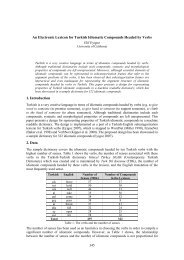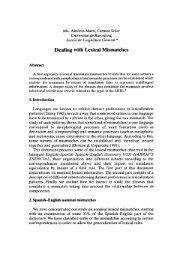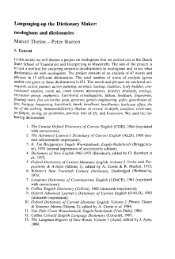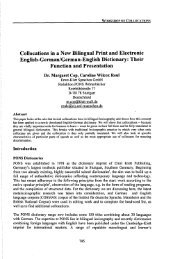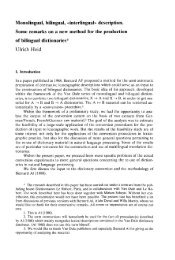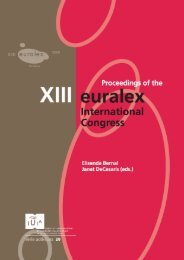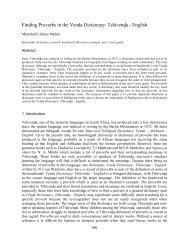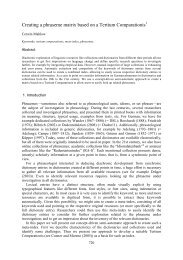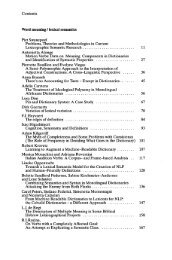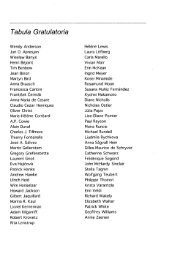Download pdf - Euralex
Download pdf - Euralex
Download pdf - Euralex
You also want an ePaper? Increase the reach of your titles
YUMPU automatically turns print PDFs into web optimized ePapers that Google loves.
3. Participants<br />
Thirty-one participants participated in the study, including eight males and twenty-three females.<br />
They were all English majors at a local university. Their ages ranged from twenty to twenty-four at<br />
the time of the study: one year 1 student, eleven year 2 students, and nineteen year 3 students.<br />
Twenty of them had learnt English for fifteen to nineteen years and eleven had learnt English for<br />
twenty years or above.<br />
4. Procedures<br />
The students participated in three dictionary consultation tasks, including a meaning<br />
determination task which required students to use a dictionary to determine the meanings of nine<br />
familiar words used in unfamiliar contexts, a sentence completion task which required students to<br />
use a dictionary to complete ten English sentences based on some given Chinese contexts, as well<br />
as a sentence construction task which required students to use a dictionary to construct ten<br />
English sentences using some given English prompts. In each task, the participants were divided<br />
into three groups, with each group using a different monolingual dictionary and doing a different<br />
self-reporting protocol, namely introspective written questionnaires, retrospective written<br />
questionnaires, and think-aloud verbal recordings. The monolingual dictionaries used in the tasks<br />
included Collins COBUILD Advanced Dictionary 6 th edition (COBUILD6)/ Collins COBUILD<br />
Learner’s Dictionary Concise Edition (COBUILD Concise), Longman Dictionary of<br />
Contemporary English 5 th edition (LDOCE5), and Cambridge Advanced Learner’s Dictionary 3 rd<br />
edition (CALD3). The groupings of the participants in the three tasks were done in a way that all<br />
students had a chance to use all the different dictionaries and to be engaged in all the three<br />
different self-reporting protocols. The numbers of participants using a certain dictionary in a<br />
certain task were comparable (about ten to eleven in each group)<br />
For the Meaning Determination Task, the participants were given a total of nine sentences<br />
and asked to determine the most appropriate meaning of the italicized expression in each<br />
sentence with the use of a dictionary by circling the correct answer from a list of five choices. For<br />
each sentence, the target lexical item for dictionary consultation was also underlined. For the<br />
Sentence Completion task, a sentence context was invented and given in written Chinese for a<br />
total of ten target words. The target English words and some parts of the corresponding English<br />
sentences were also given. The participants had to complete the sentences with the help of a<br />
monolingual dictionary. For the Sentence Construction task, three to four prompts, one of which<br />
being a target word, were given to the participants for a total of ten target words. They had to use<br />
the given prompts to construct a grammatical and meaningful English sentence with the help of a<br />
monolingual dictionary, making whatever changes to the prompts deemed necessary but<br />
following the order of the prompts (see Appendix for some sample sentences used).<br />
5. Self-Reporting Protocols<br />
The Introspective Questionnaires aimed at soliciting the participants’ instant and detailed feedback<br />
on the way a certain dictionary entry helped them in making a decision. Of relevance to the<br />
objectives of the present study were forced-choice questions requiring the participants to report on<br />
their feelings when they ended a search, as well as open-ended questions requiring the<br />
607



